Planetizen is pleased to release its list of the best books published in 2016 on the subjects of planning, design, and development.

This year's list "Top Books" share a concern for connecting the lessons of the past to the preparations for the world of the future. We can hope that the influence of this collection of books persists as long as the most famous written works of planning history.
Hopefully we're getting better at absorbing and implementing the lessons offered by these books and the canon of planning literature they join, because the world has been thrown upside down in recent weeks and months. The difference between business as usual in 2016 and what we can expect from the Trump Administration in the years to come is likely to be immeasurable, even if it remains, for the moment, unmeasurable. The process of re-evaluating assumptions and resetting the goal line for what's achievable will begin, again, in earnest in 2017.
The Planetizen editorial staff based this year's list on a number of criteria, including editorial reviews, popularity, number of references, sales figures, recommendations from experts, and the book's potential impact on the urban planning, development, and design professions. The books are listed in alphabetical order, with an addendum of honorable mentions concluding the list.
Planetizen's Top Ten Books
A Burglar's Guide to the City
Geoff Manaugh
FSG Originals
April 5, 2016, 304 pages
It takes a lot these days to write a truly original book on cities. Geoff Manaugh, well known as the author of Bldgblog, has pulled it off. Whereas most books on urban crime assume that crime is a bad thing, Manaugh takes a somewhat different tack. He doesn't exactly endorse bank heists and cat burglary, but he is genuinely impressed by the knowledge and skills that many of history's more inventive criminals use to pull off their crimes. His premise is fairly high-concept: Let's look at a city the way a criminal sees it. Buildings are not shelters; they are targets. Blueprints are not guides; they're maps. Storm drains and streets aren't infrastructure; they are escape routes.
Manaugh focuses largely on Los Angeles, which, true to its reputation for noir, is known as the bank robbery capital of the world, what with all those ten-lane escape routes. In many instances, it seems like Manaugh is stretching a little too far. How many master criminals are there, really? And shouldn't cities focus more on gang members than on catburglars? But A Burglar's Guide offers a relatively lighthearted (without being flippant), original perspective on what is otherwise a scourge. It's also a refreshing change from the ponderous, often disingenuous, concerns we hear about "safety" and "security" in the age of terrorism.
Evicted: Poverty and Profit in the American City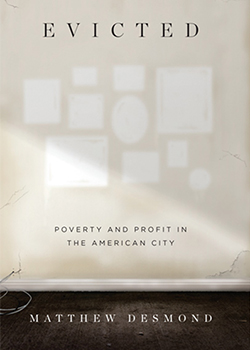
Matthew Desmond
Crown
March 1, 2016, 432 pages
Evicted is a meticulous, conscientious account of the plague of evictions that pervade America's low-income communities. A seasoned scholar, Matthew Desmond embedded himself in Milwaukee to observe firsthand the experiences of landlords and residents, the latter teetering on the edge of financial ruin and the former teetering on the edge of what the law allows. As a primary source, Evicted is masterful, telling stories that, though we can likely imagine them, generally do not get told because of the marginalization of the victims of eviction and the furtiveness of the evictors.
What Evicted lacks are the statistics and policy analyses to explain how housing in America became so fraught. Then again, statistics are not hard to come by. Desmond attempts to portray the lives behind the statistics in such a way that might spur policymakers to action. Even with Desmond's heartfelt stories, Milwaukee is still burning and millions of Americans live in fear of life out on the street.
Never Built New York
Greg Goldin and Sam Lubell
Metropolis Books
October 25, 2016, 401 pages
The same team that produced the 2013 book Never Built Los Angeles has shifted its focus eastward to the Big Apple, finding more than enough examples of dashed hopes to fill a beautiful book.
For the New York edition of the Never Built theme, Greg Goldin and Sam Lubell have gathered the images and narratives behind nearly 200 proposals, spanning 200 years of the city's grand history. The book's index is a star-studded affair, and the drawings and renderings of so many failed projects practically burst off the book's pages.
The remarkable achievement of the Never Built books is to provoke a response that negotiates the fine line between amusement and terror. Planners are familiar with the possibility of a project's failure, but the anxiety caused by that possibility pulls in opposing directions. It's possible to be deeply relieved that some projects never get built, and heartbroken, on the other hand, that some do.
The higher purpose for the Never Built project, whether it's focused on the West Coast or the East Coast, is to inspire us to think more critically about the processes that doom some projects, while ensuring others.
For fans of the Never Built idea, mark your calendars for a Never Built New York exhibit, scheduled for the Queens Museum in September 2017. In a written communication, Lubell tells Planetizen that the exhibit will include a never built world, presented on the museum's giant "Panorama of the City of New York."
The Past and Future City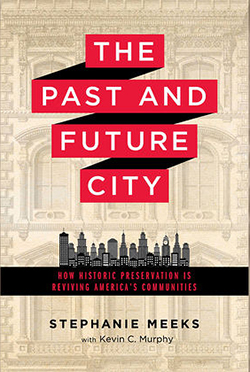
Stephanie Meeks
Island Press
October 4, 2016, 304 pages
The task of The Past and Future City is to ensure a place at the table for preservation in a new era of growth in urban areas. Giving voice to the book's arguments is Stephanie Meeks, who has served as the president and CEO of the National Trust for Historic Preservation since 2010.
The history of antipathy between developers and preservationists is well documented, and recalled in the book's first chapter. Meeks describes the historic series of battles between Jane Jacobs and Robert Moses and the loss of Penn Station as the foundation for the modern era of preservation.
The book is keenly aware, however, that the current era urban growth and capital investment offers a new set of challenges, and potential opportunities, for the preservation movement. A new type of pro-development urbanist has emerged in recent years—one who appreciates and pays top dollar for access to historic buildings while also supporting new development and architectural styles. It might not be as obvious to the 21 century urbanist why development and preservation can't benefit each other.
When this new breed of urbanist inevitably encounters the market urbanists' arguments against preservation, The Past and Future City will offer a well researched and clearly stated argument in favor of historic preservation as a key tool in the development of livable, prosperous cities.
Streetfight: Handbook for an Urban Revolution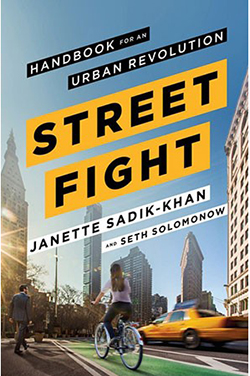
Janette Sadik-Khan and Seth Solomonow
Viking
March 8, 2016, 368 pages
Few books over the years have been such obvious choices for Planetizen’s Top Books list as Streetfight. Indeed, the story that Streetfight tells long preceded the book. As New York City transportation director under Mayor Michael Bloomberg, Janette Sadik-Khan promoted progressive transportation policy on the grandest scale. She accommodated and even favored walking, biking, and public transit over automobiles, and she championed tactical urbanism even before the term came into vogue. As brash personality befitting her city, Sadik-Khan got into her share of "fights," many of which form the basis of her narrative.
In many ways, Sadik-Khan exemplifies the value of self-promotion: a planning official who is not afraid to expose herself and "fight" for her plans—even in the face of some unhinged opposition—can accomplish a great deal. Then again, though it includes some key insights—Sadik-Khan is all about quantitative analysis, even for interventions that seem to transcend data—Streetfight isn't so much a "handbook" as it is an inspiration. As Sadik-Khan acknowledges, local activists and officials always have to adapt to their local cultures, regulations, and built environments. So it's hard to tell whether a personality that can make it in New York would make it in any town that is less toddling.
This Is Where You Belong
Melody Warnick
Viking
June 21, 2016, 320 pages
Maybe you noticed how many people were threatening to leave the country this year if the results of the presidential election didn't pan out how they hoped. Or maybe you noticed the prominence of the word exit in the year's lexicon, as #Brexit gave way to #Calexit and countless other imitators. Thrown around social media by the world's disaffected masses, the promises to leave were obviously an expression of abandonment or vengeance rather than wanderlust.
Perhaps it's an accident of history then that Melody Warnick's This Is Where You Belong emerged in 2016 as a prescription for the collective foot-out-the-door. Warnick didn't write the book in response to the existential dread produced by the 2016 presidential election; her arguments are built in response to the feeling of rootlessness cause by the sixth move of her life. The act of seeking out and earning a new job had required the move, like it does for many Americans. In fact, as Warnick notes early in the book, the average American will move 11.7 times in their lifetime.
Warnick's makes her case in gentle and affirming terms: When confronted with the temptation to retreat behind the front lawns and closed doors of the private realm, newcomers and transplants should instead explore, engage, and appreciate their new homes. This book, with its accessible prose and list of helpful resources for community engagement, reads like a guidebook for loving and nurturing every corner of America. Doing so might just be the perfect response to the events of the year.
Vital Little Plans: The Short Works of Jane Jacobs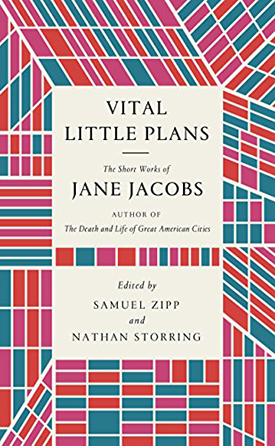
Jane Jacobs (Edited by Samuel Zipp and Nathan Storring)
Random House
October 11, 2016, 457 pages
2016 marked the 100th anniversary of the birth of Jane Jacobs. The occasion offered perhaps the best opportunity to revisit the life and work of Jacobs since she passed away in 2006, and Vital Little Plans offered the best way to do so.
Edited by Samuel Zipp and Nathan Storring, but bearing Jacobs's own name along its spine, Vital Little Plans surveys a storied career—collecting short works that span several recognizable eras, as identified by the editors. Along the way, readers will encounter magazine and newspaper work from the 1930s, speeches and previously unpublished work from the 21st century, and everything in between. Rather than coming off as a collection of rarities (although almost every reader will discover something new here), Vital Little Plans feels more like a greatest hits collection. By spanning the chronology of her career, the book illustrates the evolution of Jacobs's career in ways that any one of her books cannot.
While passages from The Death and Life of Great American Cities will remain compulsory for planning and design students for at least another century, Vital Little Plans offers new lessons in how an intellectual project can evolve given changes in time and place. In this era of innovation and political turmoil, lessons in how to improve and shift one's thinking might be the most important of all.
The Well-Tempered City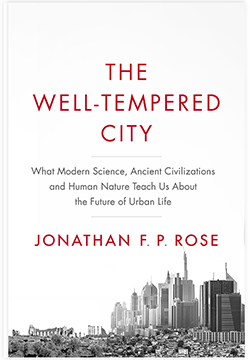
Jonathan F.P. Rose
Harper Wave
September 13, 2016, 480 pages
With more than a brief nod to Jane Jacobs and her "sidewalk ballet," Jonathan Rose takes a musical approach to his appreciation of urbanism in The Well Tempered City. Rose draws his title from a collection of Bach fugues. His message is that cities are, in addition to places of culture, places where many elements and infinite permutations come together in compositions that can be harmonious—or not. Rose deliberately goes beyond typical discussions of form and economics to arrive at the "soft skills" that can make cities great. With an eye towards both historical cities and modern ones, Rose identifies five elements that, he says, contribute to the temperament of a city: coherence, circularity, resilience, community, and compassion. Aside from the irritation of alliteration, it’s an appealing list.
Of course, it's hard to tell whether it's a prescription for great cities or just a description of the ones that have already arisen. The Well Tempered City is the kind of squishy book that comes around on a roughly annual basis, sometimes with success and sometimes not. In part, these books are the result of trying to improve upon the homespun exuberance of Jacobs and/or the academic rigor of Edward Glaeser. This is a tall order, on both ends. Rose hardly outshines those rivals, but he does add an effective, erudite voice to the chorus of those who love cities and want to help them thrive.
What Makes A Great City?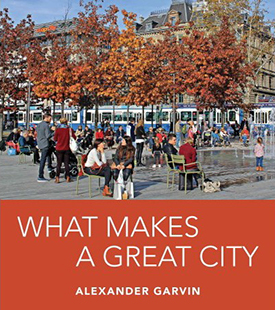
Alexander Garvin
Island Press
September 8, 2016, 344 pages
Imagine you're a renowned author, an adjunct member of the faculty at Yale University, and the president of AGA Public Realm Strategists. Would you be surprised if you found yourself unable to answer a question about the fundamental nature of cities?
That was the dilemma facing Alexander Garvin as he pondered a question from a friend: "What makes a great city?" Given the resources afforded to someone with the aforementioned accomplishments, Garvin set out to answer the question by traveling the world and identifying the common traits of great cities. His conclusion: people make cities great, and only in cities with great public realms do people have the opportunity to make a great city.
What Makes A Great City? Sometimes reads like a travelogue, with affectionate and scholarly detail afforded examples from Boston, Savannah, New York, Pittsburgh, and many more cities in the United States, as well as international examples from Europe. Therein lies one of our only complaints with the book—a lack of examples from continents not called North America or Europe.
That critique only detracts slightly from Garvin's achievements in voicing his afición for the public realm and, hopefully, providing inspiration for a generation of advocates.
Where We Want To Live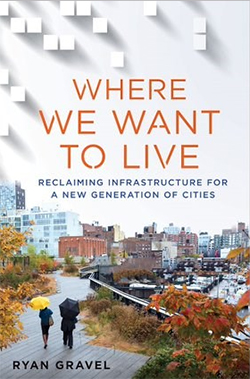
Ryan Gravel
St. Martin's Press
March 15, 2016, 256 pages
While many planners are understandably pursuing little plans, such as denser neighborhoods and tactical urbanist interventions, Ryan Gravel argues that cities still need to make big plans. These days, that means infrastructure. A local hero in Atlanta, Gravel sandwiches a dull, bureaucratic story about the creation of the Atlanta BeltLine between unexpectedly eloquent and passionate discussions about the importance of urban infrastructure and shared spaces. Given how parochial planning can be, one out of two isn't bad.
The story about the BeltLine—a 1,300-acre network of trails and open spaces encircling central Atlanta that was, like its obvious cousin the High Line, carved out of a railroad right of way—involves a lot of local politics and politicking. In the book's opening and closing thirds, Gravel explains why he cares so deeply about the BeltLine and other urban infrastructure projects, waxing poetic about everything from Parisian streets to Houston's Buffalo Bayou Park to the proposed transformation of the Los Angeles River. He convincingly argues that careful but enthusiastic investing in infrastructure, whether it's the type that brings beauty and joy or just gets people where they need to go (ideally without relying 100 percent on cars), is crucial for economic development, equity, inclusion, and well-being.
Honorable Mention
From Steel to Slots
Chloe E. Taft
Harvard University Press
April 6, 2016, 336 pages
If ever there was a moment when the world needed to understand the Rust Belt, it is now. Chloe Taft has written an intricate, scholarly portrait of the eastern Pennsylvania city of Bethlehem, that is also timely and melancholy. Taft traces the rise and fall of Bethlehem Steel, once the second-largest industrial firm in the world, and the fate of its namesake city. Unlike many other forgotten seats of industry, Bethlehem has had something of a resurrection. Parts of the old steel mill have been preserved and converted into a destination casino, creating a complicated relationship between industry and entertainment, history and postmodern kitsch. The Bethlehem casino is a property of the Las Vegas Sands Corp., owned by Sheldon Adelson. A proud piece of America's heartland has thus become dominated by a distant billionaire whose intentions may run more towards exploitation than prosperity.
Saving Our Cities: A Progressive Plan to Transform Urban America
William W. Goldsmith
Cornell University Press
September 13, 2016, 304 pages
In the valiant attempt by planners, elected officials, and citizens of all stripes to revive and upgrade America's cities, it almost goes without saying that everyone has been fighting with one hand tied behind his or her back. Regardless of how progressive the Obama Administration has been, cities have suffered at the hands of the federal government—either by neglect, incompetence, or outright malevolence—at least since the first GI Bill loan was issued and the first bulldozer puffed away in the name of urban renewal. William Goldsmith calls out the feds on three broad counts: education, nutrition, and drug policy. He probably could have picked a dozen others, but those will do. In each case, the federal government has made it hard for cities to educate and feed children and easy for them to put young adults (mostly of color) in jail. Thus, rather than support America's population centers and economic engines, the federal government has, according to Goldsmith, done the bidding of suburbanites and corporations. The politics of this situation couldn't be clearer. The book would be a timely one if only the coming years did not portend yet another era of abuse and neglect.
What a City Is For: Remaking the Politics of Displacement
Matt Hern
The MIT Press
September 23, 2016, 272 pages
With What a City Is For, Matt Hern takes on one of the most difficult topics in contemporary planning: gentrification and displacement. Hern's approach to this politically and morally fraught subject oscillates between anecdote (focusing on the Portland neighborhood of Albina) and theory. Hern's discussion of theoretical concepts never crosses the line into the self-destruct mode of much academic language, which is a revelation in its own right. Thus, Hern's approach might be just the thing many readers are looking for: a book to give shape to those nagging thoughts in the back of your mind that just won't allow you to decide what to do about these big, troubling aspects of contemporary urbanization. His prescription for the problem might be too radical for some, but the journey to get there is well worth the read.

Planetizen Federal Action Tracker
A weekly monitor of how Trump’s orders and actions are impacting planners and planning in America.

Chicago’s Ghost Rails
Just beneath the surface of the modern city lie the remnants of its expansive early 20th-century streetcar system.

Amtrak Cutting Jobs, Funding to High-Speed Rail
The agency plans to cut 10 percent of its workforce and has confirmed it will not fund new high-speed rail projects.

Ohio Forces Data Centers to Prepay for Power
Utilities are calling on states to hold data center operators responsible for new energy demands to prevent leaving consumers on the hook for their bills.

MARTA CEO Steps Down Amid Citizenship Concerns
MARTA’s board announced Thursday that its chief, who is from Canada, is resigning due to questions about his immigration status.

Silicon Valley ‘Bike Superhighway’ Awarded $14M State Grant
A Caltrans grant brings the 10-mile Central Bikeway project connecting Santa Clara and East San Jose closer to fruition.
Urban Design for Planners 1: Software Tools
This six-course series explores essential urban design concepts using open source software and equips planners with the tools they need to participate fully in the urban design process.
Planning for Universal Design
Learn the tools for implementing Universal Design in planning regulations.
Caltrans
City of Fort Worth
Mpact (founded as Rail~Volution)
City of Camden Redevelopment Agency
City of Astoria
City of Portland
City of Laramie





























